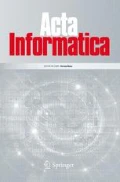Abstract
This work presents a truly concurrent operational semantics for nondeterministic data flow networks. We introduce a model, the df-process, which is a notion similar to that of non-sequential process for a Petri net: a df-process is defined as a mapping from an occurrence net K to a data flow net N, such that the places and the transitions of K are mapped onto the channels and the nodes of N. A df-process contains, by means of some labelling of the places, information on the value and the order in which data flow through the channels during a computation. Df-processes for a data flow network are characterized in an abstract way by a set of properties and in general a df-process corresponds to a set of computations of the network. We give a way to build the df-process corresponding to a computation incrementally at each event occurrence: a main result of the paper is that the incremental construction yields exactly the same set of df-processes as abstractly defined. We also show that df-processes are compositional. The model is intended to be used by distributed systems designers: it contains enough information to be a guideline for the designer and to be a base to develop dynamic checking tools. We outline how df-processes can be used in the design phase of a system.
Similar content being viewed by others
References
C. Bernardeschi, N. De Francesco, G. Vaglini: Non-sequential processes for FIFO-nets. Internal Report IR-14/93, Dipartimento di Ingegneria dell'Informazione, Università di Pisa, Italy
J. Brock, W. Ackerman: Scenarios: A Model of Non-determinate Computation. InFormalization of Programming Concepts, LNCS 107, pp. 252–259, 1981
N. De Francesco, U. Montanari, G. Ristori: Modelling Serializability via Process Equivalence in Petri Nets. HP-TR. HPL-92-89, July 1992
P. Degano, J. Meseguer, U. Montanari: Axiomatizing net computations and processes. InProc. 4-th Annual Symposium on Logic in Computer Science, Asilomar, California, pp. 175–185, 1989
H. Gaifman, V. Pratt: Partial Order Models of Concurrency and the Computation of Functions. In Symposium onLogic in Computer Science, Ithaca, New York, pp. 72–85, June 1987
U. Goltz, W. Reisig: The Non-sequential Behaviour of Petri Nets. InInformation and Computation 57, pp. 125–147, 1983
I. Guessarian (ed.): Semantics of Systems of Concurrent Processes. InProc. LITP Spring School on Theoretical Computer Science, LNCS 469, La Roche Posay, France, 1990
B. Jonsson: A Fully Abstract Trace Model for Data Flow networks. In16th Annual ACM Symp. on Principles of Programming Languages, pp. 155–165, 1989
B. Jonsson, J.N. Kok: Comparing Two Fully Abstract Data Flow Models.LNCS 379, pp. 217–234, 1989
G. Kahn: The semantics of a simple language for parallel programming. InInformation Processing 74, Noth-Holland, pp. 471–475, 1974
K. Kavi, B. Buckles, U. Bhat: Isomorphism Between Petri Nets and Data flow graphs.IEEE TSE, vol. SE-13, n 10, pp. 1127–1134, 1987
D.E. Knuth: The Art of Computer Programming.Fundamental Algorithms, 2nd ed., Addison-Wesley, Reading, Mass., 1973
J. Kok: A Fully Abstract Semantics for Data Flow Nets. InProc. PARLE, LNCS 259, Springer-Verlag, pp. 351–368, 1987
P.R. Kosinski: A Straightforward Denotational Semantics for Non-Determinate Data Flow Programs. InProc. 5th ACM Symp. on Principles of Programming Languages, pp. 214–219, 1978
R. Milner: Communication and Concurrency. Prentice-Hall International, Englewood Cliffs, 1989
C.A. Petri: Non-sequential Processes.GMD-ISF Report 77-05, 1977
A. Rabinovich, B. Trakhtenbrot: Nets of processes and data flow.Proc. Rex Workshop on Linear Time, Branching Time and Partial Order in Logics and Models for Concurrency, LNCS 354, pp. 574–602, 1988
A. Rabinovich, B. Trakhtenbrot: Behaviour structures and nets.Fundamenta Informaticae, vol. 11, n 4, pp. 357–404, 1989
A. Rabinovich, B. Trakhtenbrot: Nets and data flow interpreters.Proc. 4 th Annual Symposium on Logic in Computer Science, pp. 164–174, 1989
W. Reisig: Petri nets—an introduction.EATCS Monographs on Theoretical Computer Science, Vol. 4, Springer Verlag, 1985
G. Rozenberg (ed.): Advances in Petri nets 1990.LNCS 483, Springer Verlag, 1991
G. Rozenberg (ed.): Advances in Petri nets 1991.LNCS 524, Springer Verlag, 1991
G. Roucairol: FIFO-nets.Petri Nets: Central Models and Their Properties, LNCS 254, Springer Verlag, pp. 436–459, 1986
J. R. Russell: Full abstraction for nondeterministic data flow networks.Proc. of the 30 th Annual Symposium on Foundation of Computer Science, IEEE Press, pp. 170–177, 1989
J. Staples, V.L. Nguyen: A Fixpoint Semantics for Nondeterministic Data-flow.JACM, 32, 2, pp. 411–444, 1985
E.W. Stark: A Simple Generalization of Kahn's Principle to Inderminate Data Flow Networks.Semantics for Concurrency, Leicester, Springer Verlag, pp. 157–176, 1990
Author information
Authors and Affiliations
Additional information
Research supported in part by Progetto Coordinato CNR ANATRA
Rights and permissions
About this article
Cite this article
Bernardeschi, C., De Francesco, N. & Vaglini, G. A Petri nets semantics for data flow networks. Acta Informatica 32, 347–374 (1995). https://doi.org/10.1007/BF01178383
Received:
Issue Date:
DOI: https://doi.org/10.1007/BF01178383




